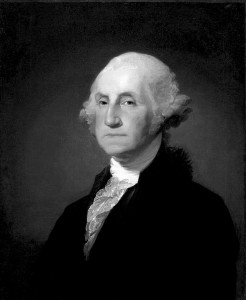By Russell W. Wylie
General George Washington was desperate to provide his army encamped at Jockey Hollow in Morristown, NJ with something to boost their morale after enduring the most brutal winter on record. The men of the Continental Army had huddled together in log huts without proper food or clothing during the winter of 1779-1780 buried under as much as six feet of snow accumulated from 28 separate snowstorms. The severe weather made it nearly impossible to get supplies to the encampment where the soldiers suffered starvation and some even resorted to eating the bark from twigs for sustenance.
It was estimated that more than a quarter of the Continental Army were Irish either by birth or ancestry. On March 16, 1780, Washington issued general orders proclaiming St. Patrick’s Day a holiday for his troops. The men of the Continental Army enjoyed a much-needed day of celebration conforming to the orders “that all fatigue and working parties cease” on March 17, 1780.
These were trying times for the leaders of the American Revolution. Congress had exhausted all their resources and the Continental paper dollar had depreciated to such an extent that there was general distrust of the paper currency.
 The prominent patriots in Philadelphia called for the organization of a bank to be known as the Bank of Pennsylvania funded by an emergency subscription on June 17, 1780 for the purpose of “obtaining supplies for the army through the agency of a bank.”
The prominent patriots in Philadelphia called for the organization of a bank to be known as the Bank of Pennsylvania funded by an emergency subscription on June 17, 1780 for the purpose of “obtaining supplies for the army through the agency of a bank.”In a stunning demonstration of patriotism, 27 members of the Friendly Sons of St. Patrick stepped forward to commit an amount, payable in gold or silver, totaling one third of the $315,000 subscription for the bank.
The Bank of Pennsylvania was the predecessor of the Bank of North America; the national bank of our fledging nation which was proposed by Robert Morris and established in 1782.
The Friendly Sons of St. Patrick showed their appreciation for General Washington’s brave leadership of the Continental Army leading to the surrender of Cornwallis at Yorktown on October 19, 1781 by naming him a member of the Society at their meeting on December 18, 1781.
Many of George Washington’s generals as well as prominent politicians and leaders of the American Revolution attended the meeting of the Society held at City Tavern on January 1, 1782 when General Washington was presented with the gold medallion signifying his membership in the Friendly Sons of St. Patrick.
General Washington also attended the Anniversary Dinner of the Society held on March 18, 1782; both this meeting and the preceding January meeting were recorded proudly as the “Washington Dinners” in the annals of the Friendly Sons of St. Patrick.
The ravages of the Revolutionary War left a severe imprint on social fraternal groups in the colonies. Some of the finest leaders had fallen in the war against England. The energies of the people were directed to the restoration and building of a new government. Interest in the activities of The Friendly Sons of St. Patrick began to wane in the late 1780s.
On March 3, 1790, John Nesbitt, president of The Friendly Sons of St. Patrick, consulted with a small group of spirited citizens of Irish birth and lineage and it was decided to broaden the base of the Friendly Sons.
A new Society was organized called the Hibernian Society for the Relief of Emigrants from Ireland. The Friendly Sons of St. Patrick had only 35 members at this time. The two Societies amalgamated. The Friendly Sons of St. Patrick as the parent, The Hibernian Society for the Relief of Emigrants from Ireland as the offspring. A charter was granted in 1792 to The Hibernian Society.
The Great Starvation in the mid-1840’s resulted in the death of over a million people and the annual emigration of hundreds of thousands sailing to North American. An outpouring of funds sent for the relief of the people of Ireland came from many organizations in America including the Society of Friends, the Boston Relief Committee, and a number of Native American tribes including the Choctaw Indians.
The merchant John Wanamaker, who later became a member of the Society in 1886, headed the Famine Relief Committee in Philadelphia.
The Society felt so strongly about the suffering of the people of Ireland that on March 10, 1847 a resolution was passed by the members to forego the Anniversary Dinner and instead make contributions to the Charity Fund “to enable the Acting Committee to meet the extraordinary call upon them which may be expected to arise from the large number of emigrants likely to arrive here during the ensuing season.”
Representatives of the Society continued to meet the influx of Irish emigrants on board ships arriving in Philadelphia and provide them with financial aid throughout the 19th century.
A formal resolution was adopted on December 17, 1897 restoring the name of the Society to The Society of the Friendly Sons of St. Patrick for the Relief of Emigrants from Ireland. On March 16, 1907, some 15,000 spectators witnessed the unveiling of a Statue of Commodore John Barry which was presented to the City of Philadelphia as a gift from the Society.
The statue, located adjacent to Independence Hall, was the work of Philadelphia native Samuel Murray also a member of the Friendly Sons and a student of Philadelphia’s greatest artist, Thomas Eakins.
A statue of Thomas Fitzsimons, erected through the efforts of the Society, was dedicated on September 16, 1946. The statue, located across the street from the front of the Cathedral Basilica of Saints Peter and Paul, was the work of the sculptor Giuseppe Donato, a student at the Pennsylvania Academy of Arts who then studied at the Ecole des Beaux-Arts and with Rodin in Paris.
In 1990, the Society commissioned a reproduction of the Book of Kells. This Illustrated Book of the Gospels was donated to the Irish Library at Gwynedd Mercy College in Gwynedd, PA where it was placed on display for viewing and research.
An Irish Studies Fund was established in December 1999 by the Society to provide scholarships for students at St. Joseph’s University to study in Ireland.
The Society provided an initial grant to investigate and design the Irish Memorial located at Front and Chestnut Streets in Philadelphia. The project, which was completed at a cost of $3 million and dedicated in October 2003, is a monument designed by the sculptor Glenna Goodacre to those who perished and those who were forced to emigrate as a result of An Gorta Mor.
On September 17, 2015, a purposeful group of new officers conducted the quarterly meeting of the Friendly Sons of St. Patrick at the Great American Pub in Conshohocken, PA. An important initiative of the meeting was the referendum on a bylaw change to admit women as members of the Society as proposed by the newly elected President Joseph P. Heenan. The members present voted in overwhelming majority in favor of the bylaw change to admit women as full members to this historic Irish American fraternal society which was founded on March 17, 1771.
The new officers, board members, and committee chairpersons have worked proactively to implement a broad-based program of organizational improvements to reduce overhead expenses and more effectively conduct quarterly meetings as revenue positive fundraising events. The operational plan for furthering the Society’s charitable mission is based on the three key areas of membership recruitment, fundraising, and benevolence.
A St. Patrick’s Gala Dinner is planned for March 12, 2016 at the Aronimink Country Club which will include the presentation of an endowment gift by the Society to provide scholarships to students at Villanova University to study in Ireland.
The crowning event of the evening will feature H.E. Anne Anderson, Irish Ambassador to the United States, as the Guest of Honor being inaugurated as the First Female Honorary Member of the Society. It will mark a significant step forward for the Society, under the guidance of the new administration with its renewed focus on liberty and charity, to achieve important progress in its historic work of forging an enduring link between all Irish American people and the Emerald Isle.
Russell W. Wylie is the secretary and a past president of the Friendly Sons of St. Patrick.


